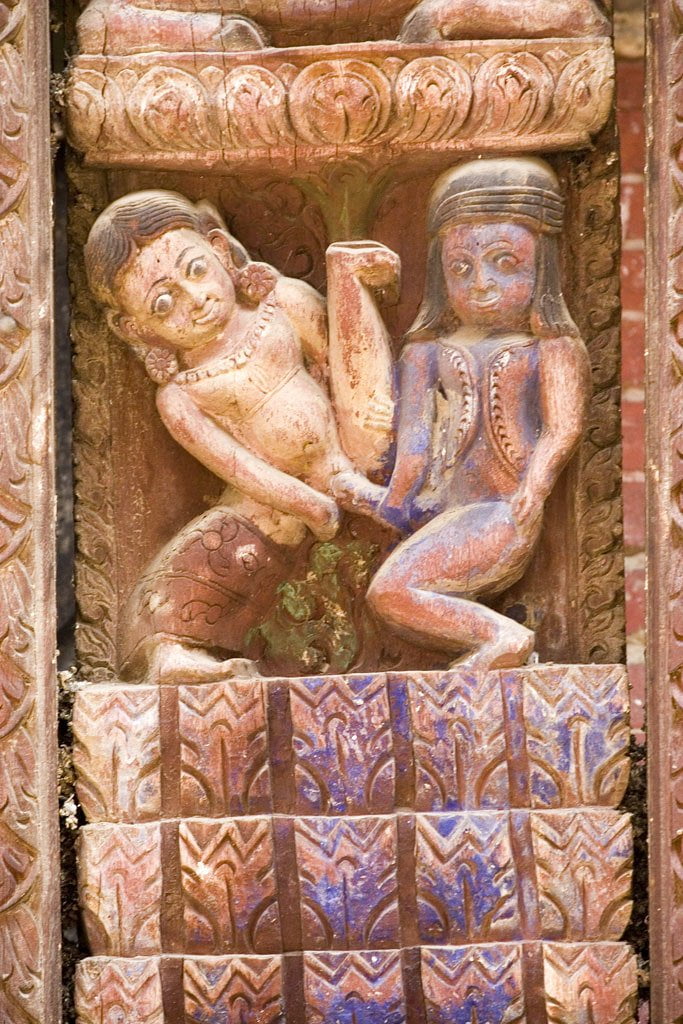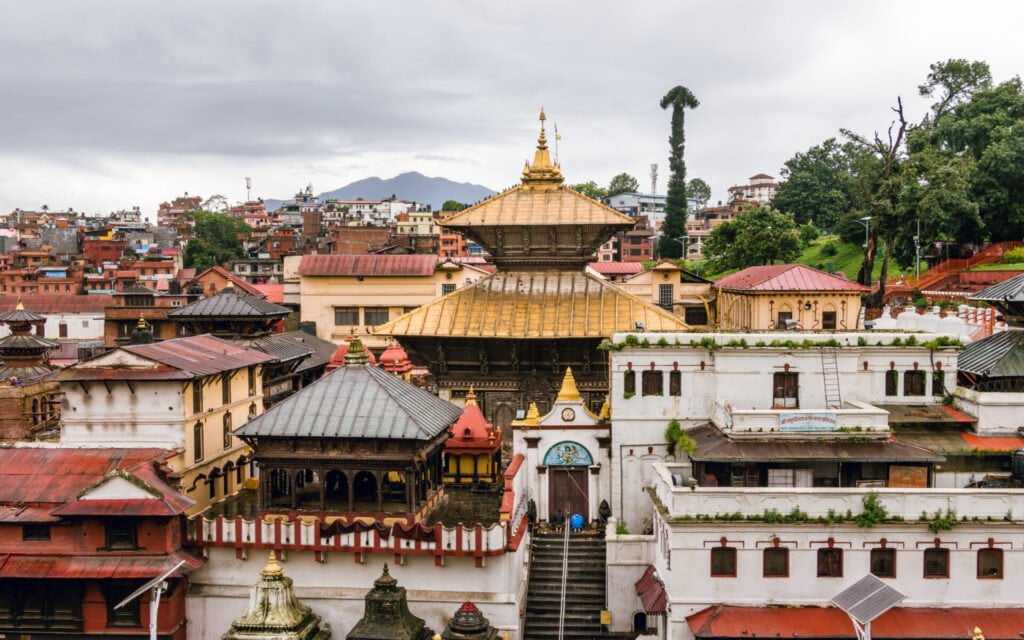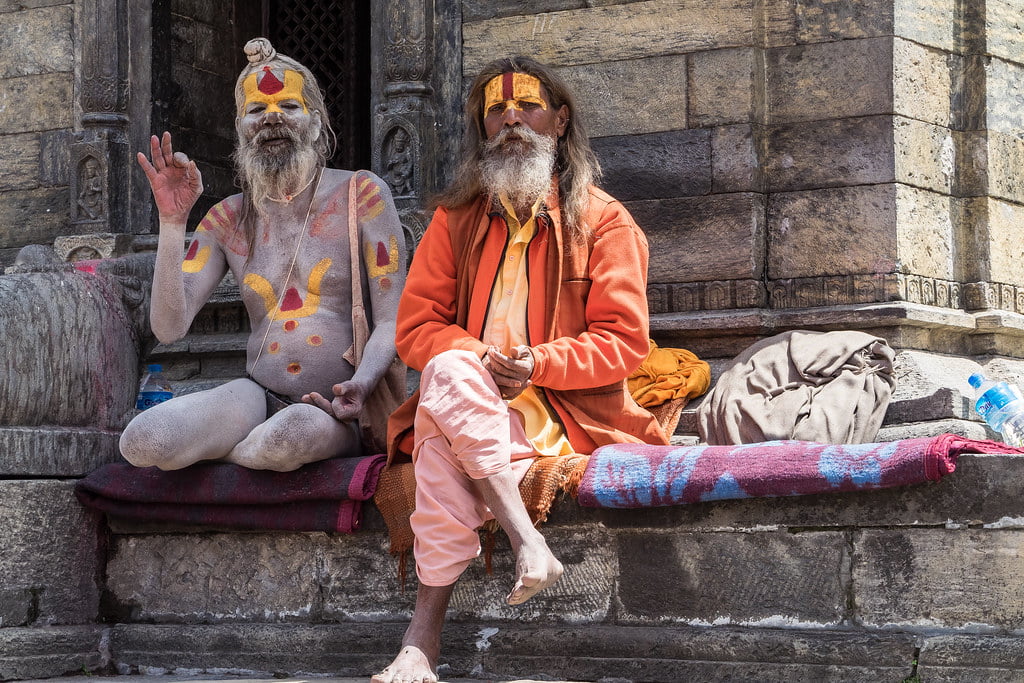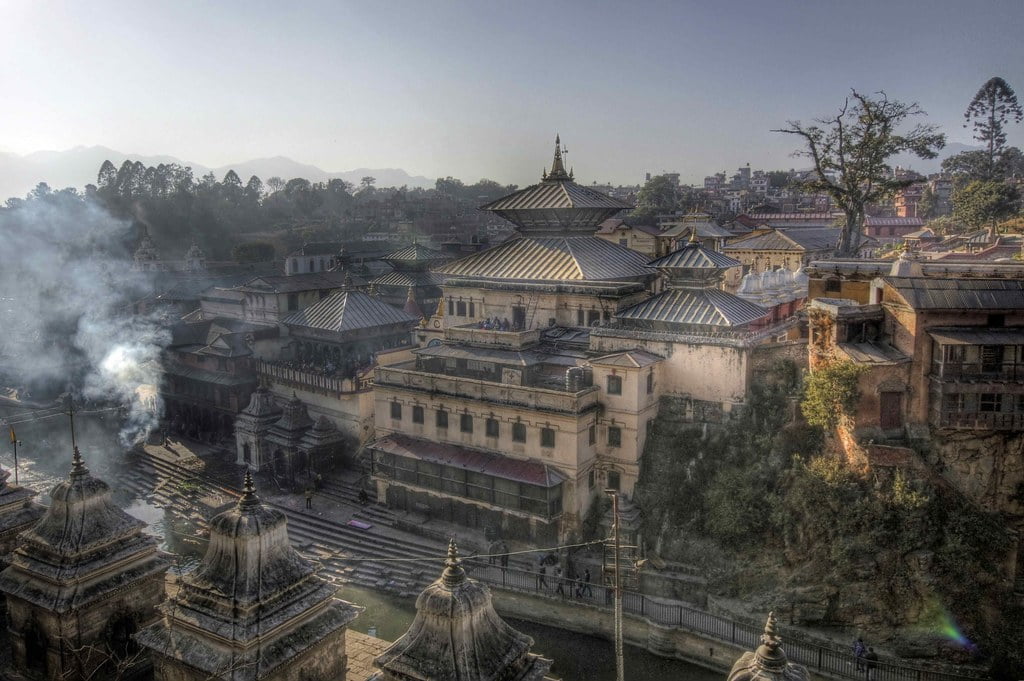Pashupatinath Temple
The Pashupatinath Temple holds immense historical significance that can be traced back for centuries. While the exact founding date remains unknown, it is believed that the temple’s origins extend back in time. The most widely accepted historical account suggests that the temple was reconstructed in the 17th century by King Bhupatindra Malla.
The temple’s historical background is closely intertwined with Nepal’s rich cultural heritage. It represents the deep-rooted religious traditions and practices of Hinduism in the country. Pashupatinath Temple holds a pivotal place in the hearts of the Nepalese people, who consider it as one of the most sacred and revered pilgrimage sites.
Over its long history, the temple has witnessed the ebb and flow of cultural and religious practices. It has played a central role in the spiritual lives of devotees, serving as a place of worship, contemplation, and devotion. The temple’s architecture reflects a unique blend of Hindu and Nepali styles, showcasing intricate woodcarvings, pagoda-style roofs, and artistic elements.
One of the significant aspects of Pashupatinath Temple is its association with cremation ceremonies. Along the banks of the Bagmati River, which flows near the temple, cremation rituals take place, symbolizing the cycle of life and death in Hinduism. This practice adds to the sanctity and spiritual significance of the temple.
In recognition of its cultural and historical importance, Pashupatinath Temple has been included in the UNESCO World Heritage List. This designation highlights the temple’s significance not only to Nepal but also to the broader world. It serves as a testament to the architectural brilliance and the deep spiritual and cultural heritage of the Nepalese people.
Visiting the Pashupatinath Temple offers a unique opportunity to immerse oneself in the rich history and spirituality of Nepal. As one explores the temple’s ornate architecture and observes the rituals performed by devotees, a sense of reverence and awe is evoked. The temple becomes a gateway to understanding the profound connection between myths, history, and spirituality.
For those interested in Hinduism and its practices, the Pashupatinath Temple provides a place of contemplation and learning. The serene atmosphere and the rituals performed within the temple’s premises offer opportunities for reflection and self-discovery.
Cultural and Religious Significance
Hindu Deities and Rituals at Pashupatinath Temple
The Pashupatinath Temple in Kathmandu, Nepal is not only a popular pilgrimage site but also a place of great significance for Hindu deities and rituals. As the temple is dedicated primarily to Lord Shiva, it holds immense importance for worshipers of this deity.
Lord Shiva is considered the supreme god in Hinduism, and his worship is deeply rooted in ancient traditions and culture. At the Pashupatinath Temple, the main deity worshiped is Lord Shiva in the form of a Shiva lingam, which represents the infinite and formless nature of the divine. Only Hindus are allowed inside the inner sanctum, where the Shiva lingam is located, due to local traditions.
The temple complex itself is not limited to just the main temple. It encompasses over 500 smaller shrines dedicated to various Hindu deities. This makes Pashupatinath Temple a hub of religious activity and an important destination for pilgrims.
One of the most notable rituals that take place at Pashupatinath Temple is the performance of last rites and cremations. As per Hindu tradition, death is seen as a transformation and an opportunity for the soul to be liberated from the cycle of birth and death. Many Hindus bring their deceased loved ones to the temple complex to perform the necessary rituals and cremate their bodies near the Bagmati River.
It is not uncommon to witness funeral processions and spot a funeral or a dead body in the vicinity of the temple. This practice highlights the belief in the power of Lord Shiva to grant moksha (liberation from the cycle of reincarnation) to the departed souls.
Apart from cremations, devotees engage in various other rituals and practices at the Pashupatinath Temple. They offer prayers, light incense, and make offerings of flowers and fruits to seek blessings from Lord Shiva. Devotees also perform circumambulation around the temple, known as pradakshina, as an act of reverence and devotion.
The temple complex also holds numerous Shiva lingams, which are a symbol of Lord Shiva’s divine energy and creative power. These lingams are scattered throughout the complex, offering devotees the opportunity to offer their prayers and seek blessings from various manifestations of Lord Shiva.
Spiritual Heritage
The Pashupatinath Temple in Kathmandu, Nepal, holds a deep spiritual heritage that resonates with devotees and visitors alike. This sacred Hindu temple complex is dedicated to Lord Pashupatinath, the embodiment of Lord Shiva, and its significance stems from its rich history and cultural importance.
The temple’s origins are believed to date back for centuries, with the most widely accepted reconstruction taking place in the 17th century by King Bhupatindra Malla. This historical background showcases the deep cultural heritage embedded within the temple, making it a pivotal place in the hearts of the Nepalese people.
The spiritual heritage of the Pashupatinath Temple is further enhanced by its connection to Hindu mythology. Lord Pashupatinath holds a significant place in Hinduism, representing the divine power of Lord Shiva. The temple is considered one of the holiest shrines of Lord Shiva, attracting devotees from all over the world who seek spiritual enlightenment and blessings.
The temple’s architectural splendor also contributes to its spiritual heritage. With its ornate architecture, intricate carvings, and stunning craftsmanship, the Pashupatinath Temple is a visual representation of devotion and spiritual beauty. The temple’s unique blend of pagoda and shikhara architectural styles adds to its allure and creates a serene and sacred atmosphere for visitors.

Architectural Marvel
Wooden Carvings: A Testament to Nepalese Craftsmanship
One of the most striking features of the Pashupatinath Temple is its elaborate wooden carvings. These intricate works of art adorn the entire structure, paying homage to the lord Pashupatinath and showcasing the rich craftsmanship that is quintessentially Nepalese.
As you approach the temple, you will be immediately captivated by the intricate details of the wooden carvings. The wooden beams that support the entire temple are adorned with figures of holy beings, depicting scenes from ancient mythology and religious texts. Every figure is meticulously carved with precision and care, demonstrating the skill and dedication of the craftsmen who created them.
The wooden carvings not only serve as a decorative element but also hold great religious significance. Each carving tells a story, symbolizing the rich cultural heritage and spiritual beliefs of the Nepalese people. These carvings are a testament to the devotion and reverence that the Nepalese have for their gods and goddesses.
The craftsmanship displayed in the wooden carvings is a result of centuries-old traditions passed down from generation to generation. The intricate details and patterns are achieved through a meticulous process that requires immense skill and patience. The craftsmen use traditional tools and techniques, ensuring that the art form remains authentic and true to its roots.
It is not just the beauty of the carvings that make them special, but also the materials used. The wood chosen for the carvings is carefully selected for its durability and resistance to weathering. This allows the wooden carvings to withstand the test of time, preserving their beauty for generations to come.
The wooden carvings at the Pashupatinath Temple are not only a visual delight but also a reflection of the rich cultural heritage and spiritual significance of Nepal. They serve as a reminder of the skill and dedication of the craftsmen who brought them to life and continue to inspire awe and admiration in visitors from around the world.
Visiting the Pashupatinath Temple and witnessing the intricate wooden carvings is an experience that cannot be missed. It offers a glimpse into the rich artistic traditions of Nepal and allows one to appreciate the depth of devotion and craftsmanship that goes into creating such masterpieces.
Temple Precincts: A Sacred and Vibrant Space
The Pashupatinath Temple in Kathmandu, Nepal, is a sprawling and captivating Hindu temple precinct that draws thousands of devotees and visitors from all over the world. This extensive complex, classified as a World Heritage Site, stretches over an area of 246 hectares along the banks of the sacred Bagmati River, creating a serene and enchanting atmosphere.
Within the temple precincts, one can find a magnificent collection of temples, ashrams, images, and inscriptions that have been raised over the centuries. With 518 mini-temples and a grand main pagoda house, the Pashupatinath Temple is a sight to behold. The architectural brilliance, intricate carvings, and vibrant colors of the temples leave visitors in awe of the rich cultural heritage and religious significance of this holy site.
As you enter the temple precincts through the ornate entrance gate, you are immediately enveloped in an atmosphere of spirituality and devotion. The air is filled with the sound of prayers and chants, creating a surreal ambiance that invites you to connect with the divine. The devotees, dressed in traditional attire, move about the temple complex, offering their prayers and seeking blessings from Pashupati, a form of Lord Shiva.
Amidst the hustle and bustle of the temple, it is important to maintain a quiet and reverent demeanor, respecting the sacredness of the space. The Pashupatinath Temple is a place of deep religious significance, and visitors are encouraged to embrace the tranquility and spiritual energy that permeates the surroundings.
While exploring the temple precincts, it is customary to remove your shoes before stepping inside the prayer hall. This act not only ensures proper hygiene but also embodies a gesture of respect and humility towards the divine. The temple complex is a place of purity and sanctity, and adhering to these cultural conventions helps preserve the sacredness of the environment.
As you wander through the temple grounds, you may come across devotees engaged in various rituals and ceremonies. The Pashupatinath Temple is known for its vibrant festivals and religious observances. The festival calendar plays an important role in planning your visit, as it allows you to witness the temple come alive with fervent devotion and colorful celebrations.

Importance of Pashupatinath in Nepalese Society
Religious Ceremonies and Practices at Pashupatinath Temple
Pashupatinath Temple in Nepal is not only a significant religious site but also a hub of various religious ceremonies and practices. This sacred temple offers visitors a unique opportunity to witness ancient rituals and experience the rich cultural heritage of Nepal.
The temple hosts a plethora of religious ceremonies that provide insights into the traditional practices and beliefs of the Nepali people. Visitors can observe devotees and priests engaging in these rituals, often characterized by chanting, offering of prayers, and the lighting of oil lamps. These ceremonies create a spiritual ambiance that resonates with the deep-rooted devotion of the worshippers.
One of the highlights of visiting Pashupatinath Temple is timing your visit with Hindu festivals like Maha Shivaratri. During these festivals, the temple comes alive with vibrant celebrations, processions, and music. The atmosphere is filled with joy and excitement as devotees gather to pay homage to Lord Shiva. Participating in these festivals allows visitors to immerse themselves in the cultural fabric of Nepal and witness the religious fervor of the devotees.
Cremation Ghats: Witnessing the Sacred Rituals of Hindu Funeral Customs
One of the most profound and spiritually significant aspects of the Pashupatinath Temple complex is the presence of the cremation ghats along the banks of the sacred Bagmati River. These designated areas, where cremation ceremonies are performed, offer visitors a unique and awe-inspiring glimpse into the ancient funeral customs of Hinduism.
The cremation ghats at Pashupatinath are not only a site for the physical departure of the deceased but also a reflection of the cultural and religious tapestry woven into the fabric of Hinduism. Here, grief and spirituality intertwine, creating a space where the brief nature of life and the belief in the endless cycle of reincarnation are emphasized.
As one walks along the Bagmati River, the solemnity and reverence of the cremation ghats become apparent. Families dressed in white gather to bid farewell to their loved ones, following age-old practices guided by religious scriptures. The atmosphere is filled with a deep sense of devotion as the smoke from the funeral pyres mingles with the air, symbolizing the connection between life and death.
The Bagmati River, revered in Hinduism, serves as both a physical and spiritual route, carrying not only the ashes of the departed but also their souls towards spiritual liberation. The rituals performed at the cremation ghats are believed to represent the soul’s journey from the physical world to the spiritual realm.
The significance of the cremation ghats goes beyond the immediate ceremony. In Hinduism, death is seen not as an end but as a transition to another life. The rituals performed at the ghats are believed to ensure the smooth journey of the departed soul to the afterlife and pave the way for their reincarnation. The ghats serve as a sacred space where the cycle of life and death is acknowledged and honored.
The Pashupatinath Temple complex is home to two major ghats: the Western ghats and the Eastern ghats. The Western ghats, considered the holiest part of the Bagmati River, are primarily used for cremation ceremonies. It is believed that Lord Shiva himself spent time near this bank in his deer form, and thus, anyone cremated here is believed to be reborn as a human in their next life. The Eastern ghats, on the other hand, are more popular for ceremonial rituals than funeral rites.

Tourist-Friendly Aspects
Special Events and Pujas
The Pashupatinath Temple is not only a place of worship but also a center for various special events and pujas that are held throughout the year. These events attract a large number of devotees and tourists, adding to the vibrant atmosphere of the temple.
One of the most significant events celebrated at the Pashupatinath Temple is the Maha Shivaratri festival. This annual festival, dedicated to Lord Shiva, draws thousands of devotees from Nepal and India. The temple is adorned in the most spectacular way, with flowers and floral garlands decorating every doorway, passage, and balcony. Ascetics and pilgrims gather at the temple grounds to worship Lord Shiva and seek his blessings. It is a day of fasting, ritual dips in the holy Bagmati River, and prayers for happiness and prosperity.
Another notable event celebrated at the temple is the Teej festival. This festival primarily attracts women who come dressed in red sarees to pray for a long and happy married life with their partners. The sight of women performing traditional rituals and offering prayers in devotion is truly mesmerizing.
Apart from these major events, the Pashupatinath Temple also hosts various daily pujas and rituals. The Abhishekam, which is performed from 9:00 AM to 11:00 PM, is a special ceremony where all four faces of the Shiva Lingam are visible to the devotees. During this time, the temple is filled with the chanting of mantras and the ringing of bells, creating a sacred ambiance.
Visitors to the temple can also witness other pujas being conducted by sadhus and pandits on the eastern ghats of the Bagmati River. These rituals add to the mystical environment of the temple, with devotees seeking blessings and spiritual solace.
The Pashupatinath Temple is not just a religious site but also a cultural hub where people from different backgrounds and beliefs come together to celebrate and connect with their spirituality. Whether you are a devotee or a curious traveler, witnessing these special events and pujas at the temple is a unique and enriching experience.
Tourist Information
When visiting the Pashupatinath Temple in Nepal, there are several important things that tourists should know to make the most of their experience. Here is some essential tourist information to keep in mind:
- Access and Entry: The Pashupatinath Temple is located about 5 kilometers northeast of Kathmandu, on the banks of the Bagmati River. The temple complex is easily accessible by road and can be reached via public transportation or private vehicles. Non-Hindus are now allowed to enter and explore the temple complex freely, although entry into the main temple and inner sanctums is restricted to Hindus only. Tourists are allowed to wander around the temple grounds, witness Hindu cremation ceremonies on the eastern banks of the Bagmati River, and observe the ascetics in the complex.
- Temple Architecture: The Pashupatinath Temple is an architectural marvel, built in the Nepalese pagoda style. It features a two-tiered roof made of copper layered with gold, and a spire made of solid gold at the top. The intricate craftsmanship and cultural significance of the temple make it a sight worth exploring and admiring.
- Photography and Etiquette: Tourists are encouraged to capture the beauty of the temple complex through photography. The ascetics in the complex, with their unique attire, are often photographed by foreign tourists and photographers. However, it is important to respect the religious and cultural practices of the temple. Visitors should dress modestly and be mindful of their behavior to maintain the sanctity of the place.
- Wildlife and Natural Surroundings: Pashupatinath Temple is known as the Lord of All Animals, and as such, it is home to various wildlife species. Deer and monkeys roam freely in the nearby deer park and temple grounds, and no harm is inflicted upon them by anyone. Tourists can enjoy observing these animals in their natural habitat while exploring the temple complex.
- Nearby Destinations: For those looking to explore further, there are several destinations close to Pashupatinath Temple worth visiting. Siliguri, Gangtok, and Pokhara are popular nearby cities that offer unique cultural experiences and natural beauty. Additionally, there are historical places, restaurants, and food markets in Allahabad and Gangtok that tourists can explore.
- Safety and Travel Tips: It is important for tourists to take necessary safety precautions while visiting Pashupatinath Temple and its surroundings. Valuables should be kept hidden, and it is advisable to travel in groups or join organized sightseeing tours. Additionally, tourists should familiarize themselves with local transportation routes, obtain the necessary permits and cards for trekking and park entry, and be aware of the local tourist police who ensure safety in the region.
By keeping these tourist information points in mind, visitors to Pashupatinath Temple can have a fulfilling and enriching experience, exploring the temple’s historical and cultural significance while respecting the traditions and customs of the place.

